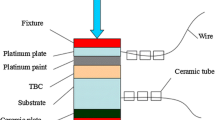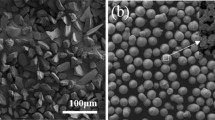Abstract
For thin films, by reason of their specific nature, the determination of many properties intrinsic to compact materials is a well-known problem. This is particularly the case with one of the most important functional properties of thermal barrier coatings, namely, thermal conductivity. Therefore, the problem addressed in the present work is to develop the method of estimation of thermal conductivity of relatively thin coatings (up to 200 μm) through characteristics that can be easily measured in the experiment. This method includes the experimental measurement of the Volta potential difference of coatings and calculations of their thermal conductivity through the actual elemental and phase composition, which is determined by instrumental methods of metallography, X-ray diffraction, and spectroscopy. The investigation is performed on Nb-Ti-Al- and Zr-Ti-Al-based thermal barrier coatings about 80 μm in thickness deposited by the vacuum ion-plasma technology on a substrate made of nickel superalloy Inconel 713LC, which is used in the manufacture of first-stage blades of aircraft, locomotive and ship gas turbine engines. Despite the close chemical composition, the coatings have fundamentally different structures and phase compositions after long-term deposition and subsequent heat treatment. Structural features of the coatings affect the Volta potential difference measured by the original method. The developed calculation and analytical model for thermal conductivity also accounts for structural characteristics. Thermal conductivity values calculated by the presented model are highly correlated with the experimentally measured values of the Volta potential difference for single-phase alloys (Inconel 713LC) and single-phase layered coatings (Nb-Ti-Al). For multiphase coatings with a 3D composite structure (Zr-Ti-Al), the model shows insufficient correlation between the calculated and experimental values and needs to be corrected.













Similar content being viewed by others
REFERENCES
Sourmail, T., Coatings for Turbine Blades, Cambridge, 2003. URL: Coatings for Turbine Blades (cam.ac.uk)
Kablov, E.N. and Muboyadzhyan, S.A., Heat-Resistant and Thermal Barrier Coatings for High-Pressure Turbine Blades of Promising Gas Turbine Engines, Aviats. Mat. Tekh., 2012, no. 5, pp. 60–70. eLIBRARY ID: 18084820
Luo, Q., Zhou, Z., Rainforth, W.M., and Bolton, M., Effect of Tribofilm Formation on the Dry Sliding Friction and Wear Properties of Magnetron Sputtered Tialcryn Coatings, Tribology Lett., 2009, vol. 34, pp. 113–124. https://doi.org/10.1007/s11249-009-9415-9
Luo, Q., Hovsepian, P.E., Lewis, D.B., Munz, W.D., Kok, Y.N., Cockrem, J., Bolton, M., and Farinotti, A., Tribological Properties of Unbalanced Magnetron Sputtered Nano-scale Multilayer Coatings TiAlN/VN and TiAlCrYN Deposited on Plasma Nitrided Steels, Surf. Coat. Technol., 2004, vol. 193(1–3), pp. 39–45. http://shura.shu.ac.uk/1133/
Evans, A.G., Mumm, D., Hutchinson, J.W., Meier, G., and Pettit, F., Mechanisms that Control the Durability of Thermal Barrier Coatings, Adv. Mater. Sci., 2001, vol. 46, pp. 505–553. https://doi.org/10.1016/S0079-6425(00)00020-7
Zhigachev, A.O., Golovin, Yu.I., Umrikhin, A.V., Korenkov, V.V., Tyurin, A.I., Rodaev, V.V., Dyachek, T.A., and Farber, B.Ya., High-Tech Nanostructured Ceramics Based on Zirconium Dioxide, Golovin, Yu.I., Ed., Moscow: Tekhnosfera, 2020.
Padture, N.P., Gell, M., and Jordan, E.H., Thermal Barrier Coatings for Gas Turbine Engine Applications, Science, 2002, vol. 296, pp. 280–284. https://doi.org/10.1126/science.1068609
Kim, G.M., Yanar, N.M., Hewitt, E.N., and Pettit, F., Influence of the Type of Thermal Exposure on the Durability of Thermal Barrier Coating, Scripta Mater., 2002, vol. 46, pp. 489–495. https://doi.org/10.1016/S1359-6462(02)00016-7
Schulz, U., Some Recent Trends in Research and Technology for Advanced Thermal Barrier Coatings, Aero. Sci. Tech., 2003, vol. 7, pp. 73–80. https://doi.org/10.1016/S1270-9638(02)00003-2
Tushinskii, L.I., Plokhov, A.V., Tokarev, A.O., and Sindeev, V.I., Methods of Material Research. Structure, Properties, and Deposition of Inorganic Coatings, Moscow: Mir, 2004.
GOST 7076-99: Building Materials and Products. Method of Determination of Steady-State Thermal Conductivity and Thermal Resistance.
Kudinov, V.V. and Ivanov, V.M., Plasma Deposition of Refractory Coatings, Moscow: Mashinostroenie, 1981.
GOST 30256-94: Building materials and products. Method of Thermal Conductivity Determination by Cylindrical Probe.
Buzovkina, T.B., Sokolova, T.V., Obukhov, A.P., Uspenskaya, R.I., and Degen, M.G., Effect of Structural Parameters and of Temperature on the Effective Thermal Conductivity of Plasma-Deposited Coatings of Aluminum Oxide, High Temp., 1972, vol. 10, no. 2, pp. 345–348.
Mazilin, I.V., Baldaev, L.Kh., Drobot, D.V., Akhmetgareeva, A.M., Zhukov, A.O., and Khismatullin, A.G., Thermal and Thermophysical Properties of Thermal Barrier Coatings Based on Lanthanum Zirconate, Perspekt. Mat., 2013, no. 7, pp. 21–30.
Parker, W.J., Jenkins, R.J., Butler, C.P., and Abbott, G.L., Flash Method of Determining Thermal Diffusivity, Heat Capacity and Thermal Conductivity, J. Appl. Phys., 1991, vol. 32, pp. 1679–1684. https://doi.org/10.1063/1.1728417
Nicholls, R., Lawson, K.J., Johnston, A., and Rickerby, D.S., Low Thermal Conductivity EB-PVD Thermal Barrier Coatings, in High Temperature Corrosion. Trans. Tech. Publ., 2001, pp. 595–606. https://doi.org/10.4028/www.scientific.net/MSF.369-372.595
Altun, O., Erhan Boke, Y., and Kalemtas, A., Problems for Determining the Thermal Conductivity of TBCs by Laser-Flash Method, J. Achiev. Mater. Manuf. Eng., 2008, vol. 30, no. 2, pp. 115–120.
Hemberger, F., Gobel, A., and Ebert, H.P., Determination of the Thermal Diffusivity of Electrically Non-Conductive Solids in the Temperature Range from 80 K to 300 R by Laser Flash Measurement, Int. J. Thermophys., 2010, vol. 31, pp. 2187–2200. https://doi.org/10.1007/s10765-010-0876-8
Loshchinin, Yu.V., Folomeikin, Yu.I., and Pakhomkin, S.I., Study of the Heat Capacity of Coated Metal Materials by Laser Flash Method, Zavod. Lab. Diagn. Mat., 2015, vol. 81, no. 9, pp. 40–44. eLIBRARY ID: 24347011
Loshchinin, Yu.V., Budinovskii, S.A., and Razmakhov, M.G., Thermal Conductivity of Rare Earth Oxide Doped Thermal Barrier Coatings ZrO2–Y2O3 Deposited by Magnetron Sputtering, Aviats. Mat. Tekh., 2018, vol. 53, no. 3, pp. 21–49. https://doi.org/10.18577/2071-9140-2018-0-3-42-49
ASTM E1461. Standard Test Method for Thermal Diffusivity by the Flash Method. ASTM Standards, American Society for Testing and Materials-Philadelphia, 2002.
Gulyaev, A.P., Science of Metals, Moscow: Metallurgiya, 1986.
Engineering Properties of Alloy 713C, pp. 4–5. https://nickelinstitute.org/media/2487/alloys-713c_337.pdf
Kittel, Ch., Introduction to Solid State Physics, Hoboken, USA: John Wiley & Sons, 2005.
Banerjee, D.A., A New Ordered Orthorhombic Phase in Ti3Al-Nb Alloy, Acta Metall., 1988, vol. 36, pp. 871–872. https://doi.org/10.1016/0001-6160(88)90141-1
Chaumat, V., Ressouche, E., Ouladdiaf, В., Desre, P., and Moret, F., Experimental Study of Phase Equilibria in the Nb-Ti-Al System, Scripta Mater., 1999, vol. 40(8), pp. 905–911. https://doi.org/10.1016/S1359-6462(99)00032-9
Polkin, I.S., Kolachev, B.A., and Ilyin, A.A., Titanium Aluminides and Alloys on Their Basis, Tekhn. Legk. Spl., 1999, no. 3, pp. 32–39.
Peng, J.H., Mao, Y., Li, S.Q., and Sun, X.F., Microstructure Controlling by Heat Treatment and Complex Processing for Ti2AlNb Based Alloys, Mater. Sci. Eng. A, 2001, vol. 209, pp. 75–80. https://doi.org/10.1016/S0921-5093(00)01417-9
Raghavan, V., Al-Nb-Ti (Aluminum–Niobium–Titanium), J. Phase Equilib. Diffus., 2005, vol. 26(4), pp. 360–368. https://doi.org/10.1361/154770305X56863
Kazantseva, N.V. and Lepikhin, S.V., Investigation of the Ti-Al-Nb Phase Diagram, PMM, 2006, vol. 102, no. 2, pp. 169–180.
Kahrobaee, Z. and Palm, M., Critical Assessment of the Al-Ti-Zr System, J. Phase Equilib. Diffus., 2020, vol. 41, pp. 687–701. https://doi.org/10.1007/s11669-020-00837-x
Lu, K.L., Yang, F., Xie, Z.Y., Liu, H.S., Cai, G.M., and Jin, Z.P., Isothermal Section of Al-Ti-Zr Ternary System at 1073 K, Trans. Nonferrous Met. Soc. China, 2016, vol. 26, pp. 3052–3058. https://doi.org/10.1016/S1003-6326(16)64436-9
URL: www.himikatus.ru
Pchelintsev, A.N. and Shishin, V.A., Relaxation Time of Conduction Electrons in Metals, Vest. Tambov. Gos. Tekh. Univ., 2003, vol. 9, no. 3, pp. 464–468. eLIBRARYID: 18867465
Zarubin, V.S., Kuvyrkin, G.N., and Savelyeva, I.Yu., Thermal Conductivity of Fiber-Reinforced Composite, Izv. Vuzov. Mashinostr., 2013, no. 5, pp. 75–81. https://doi.org/10.18698/0536-1044-2013-5-75-81
Zarubin, V.S., Kuvyrkin, G.N., and Savelyeva, I.Yu., The Self-Consistency Scheme Estimation of Effective Thermal Conductivity for the Transversally Isotropic Composite with Isotropic Ellipsoidal Inclusions, Vest. Mosk. Gos. Tekh. Univ. Bauman. Estest. Nauki., 2015, vol. 60, no. 3, pp. 99–109. https://doi.org/10.18698/1812-3368-2015-3-99-109
Carslaw, H.S. and Jaeger, J.C., Conduction of Heat in Solids, Oxford, Great Britain: Oxford University Press, 1959.
SAE AMS5391G-2013 Nickel Alloy, Corrosion and Heat Resistant. Standard by SAE International.
Funding
This work was supported by the Russian Science Foundation (grant No. 21-79-30007).
Author information
Authors and Affiliations
Corresponding author
Rights and permissions
About this article
Cite this article
Kolesnikov, V.I., Kudryakov, O.V., Varavka, V.N. et al. Estimation of Thermal Conductivity of Thermal Barrier Coatings through Measured Electronic and Structural Characteristics. Phys Mesomech 25, 195–213 (2022). https://doi.org/10.1134/S1029959922030018
Received:
Revised:
Accepted:
Published:
Issue Date:
DOI: https://doi.org/10.1134/S1029959922030018




